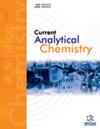Comparative Evaluation of the Essential Oil Content of Asteraceae Family Medicinal Plants
IF 1.7
4区 化学
Q3 CHEMISTRY, ANALYTICAL
引用次数: 0
Abstract
Background: The Asteraceae family comprises the largest flowering plant species, which have also been proven to have medicinal value for various illnesses due to the presence of numerous volatile and non-volatile constituents. Objective: The study aims to compare the volatile phytoconstiteunts presence in the essential oils of Asteraceae family plants including Roman Chamomile Oil (Chamaemelum nobile), German Chamomile Oil (Matricaria chamomilla), Davana Oil (Artemisia pallens), Wormwood Oil (Artemisia absinthium), Armoise Oil (Artemisia vulgaris), Tansy Oil (Tanacetum vulgare), Yarrow Oil (Achillea millefolium), Tarragon Oil (Artemisia dracunculus), Tagetes Oil (Tagetes erecta) and Immortelle Absolute Oil (Helichrysum italicum) as simultaneous estimation using the novel methods. Methods: Roman chamomile, German chamomile, davana, wormwood, armoire, tansy, yarrow, tarragon, tagetes, and immortelle absolute oils were extracted by steam distillation from their respective Asteraceae species and carried out the gas chromatography analysis. Results: The result was that GC-MS analysis of selected essential oils contains terpenes and terpenoids in major amounts. Among the detected volatile constituents in crucial oils Methyl Chavicol was found higher 75.63% in Tarragon Oil compared to other constituents followed Neryl acetate (60.25%) found in the immortelle absolute oil, Cis davanone (55.36%) was found in the davana oil, Ocimene (45.58%) in the tagetes oil, α-bisabololoxide B (45.26%) in the German chamomile oil, Beta thujone (50.65%) in the tansy oil, Alpha thujone (40.21%) in the wormwood oil and Camphor (38.65%) in the armoise oil. 1,8-Cineole, Alpha pinene, and Camphene were found in three oils (Wormwood oil, Armoise oil and Yarrow oil) among the selected oils. result: The results revealed the majority of terpenes and terpenoid-natured compounds. Methyl Chavicol (75.634%) was the highest content found in the tarragon oil when compared to the compounds found in the ten Asteraceae essential oils. The compounds such as Neryl acetate (60.251%) werefound in the immortelle absolute oil, Cis davanone (55.3640%) was found in the davana oil, Ocimene (45.5856%) in the tagetes oil, α-bisabololoxide B (45.2655%) in the German chamomile oil, Beta thujone (50.6520%) in the tansy oil, Alpha thujone (40.2150%) in the wormwood oil and Camphor (38.654%) in the armoise oil. 1,8-Cineole, Alpha pinene and Camphene were the compounds found in three of the ten Asteraceae essential oils Conclusion: Finally, we concluded that species from the same family (Asteraceae) were biologically synthesized with different volatile constituents. Hence, each essential oil has a unique biochemical fingerprint. These findings will help the food industry in relation to natural flavoring.菊科药用植物精油含量的比较评估
背景:菊科是开花植物种类最多的科,由于含有大量挥发性和非挥发性成分,已被证明对多种疾病具有药用价值。研究目的本研究旨在比较菊科植物精油(包括罗马洋甘菊精油(Chamaemelum nobile)、德国洋甘菊精油(Matricaria chamomilla)、达瓦纳精油(Artemisia pallens)、艾蒿精油(Artemisia absinthium))中的挥发性植物固醇、用新方法同时估算出 Armoise 油(Artemisia vulgaris)、Tansy 油(Tanacetum vulgare)、Yarrow 油(Achillea millefolium)、Tarragon 油(Artemisia dracunculus)、Tagetes 油(Tagetes erecta)和 Immortelle Absolute 油(Helichrysum italicum)的含量。方法采用蒸汽蒸馏法从各自的菊科植物中提取罗马洋甘菊、德国洋甘菊、达瓦纳、艾草、臂蒿、丹参、蓍草、龙蒿、万寿菊和仙人掌精油,并进行气相色谱分析。结果显示气相色谱-质谱分析结果表明,所选精油中含有大量萜烯和萜类化合物。在检测到的重要精油挥发性成分中,龙蒿精油中的甲基茶维醇含量比其他成分高 75.63%,其次是醋酸橙花酯(60.25%),长春花精油中的顺式达瓦酮(55.36%)、虎耳草油中的奥西孟(45.58%)、德国洋甘菊油中的α-双羟基苯酚 B(45.26%)、丹参油中的β-��酮(50.65%)、艾草油中的α-��酮(40.21%)和樟脑(38.65%)。在所选的精油中,有三种精油(艾草精油、阿尔莫斯精油和西洋蓍草精油)含有 1,8-蒎烯、α-蒎烯和莰烯:结果表明,大多数油中都含有萜烯和萜类化合物。与十种菊科植物精油中发现的化合物相比,龙蒿油中的甲基茶维醇(75.634%)含量最高。在长春花精油中发现了乙酸橙花酯(60.251%),在达瓦那精油中发现了顺式达瓦酮(55.3640%),在虎尾兰精油中发现了奥西烯(45.5856%),在德国野菊花精油中发现了α-二羟基二苯甲醚 B(45.2655%)。2655%)、丹参油中的β-�侧酮(50.6520%)、艾草油中的α-�侧酮(40.2150%)和麝香草油中的樟(38.654%)。1,8-蒎烯、α-蒎烯和莰烯是十种菊科精油中三种发现的化合物:最后,我们得出结论:同属菊科的物种在生物合成过程中会产生不同的挥发性成分。因此,每种精油都有独特的生化指纹。这些发现将有助于食品工业对天然香料的研究。
本文章由计算机程序翻译,如有差异,请以英文原文为准。
求助全文
约1分钟内获得全文
求助全文
来源期刊

Current Analytical Chemistry
化学-分析化学
CiteScore
4.10
自引率
0.00%
发文量
90
审稿时长
9 months
期刊介绍:
Current Analytical Chemistry publishes full-length/mini reviews and original research articles on the most recent advances in analytical chemistry. All aspects of the field are represented, including analytical methodology, techniques, and instrumentation in both fundamental and applied research topics of interest to the broad readership of the journal. Current Analytical Chemistry strives to serve as an authoritative source of information in analytical chemistry and in related applications such as biochemical analysis, pharmaceutical research, quantitative biological imaging, novel sensors, and nanotechnology.
 求助内容:
求助内容: 应助结果提醒方式:
应助结果提醒方式:


